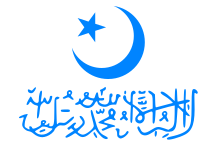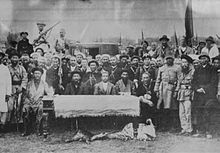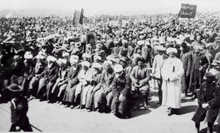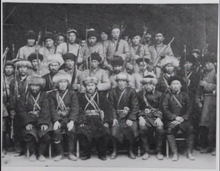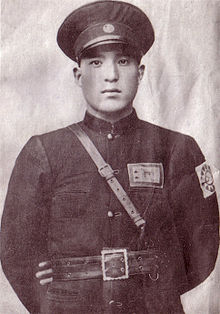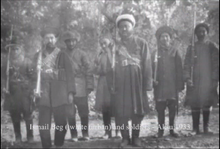Islamic Republic of East Turkestan
The Islamic Republic of East Turkestan , known as the First East Turkestan Republic ( Uighur شەرقىي تۈركىستان ئىسلام جۇمھۇرىيىتى Sherqiy Türkistan Islam Jumhuriyiti , Chinese 东突厥斯坦 第一 共和国 , Pinyin Dōng Tūjuésītǎn dìyī Gònghéguó , dʊŋ kʊŋ˥˩xə˧˥kuɔ˧˥ ), was the short-lived attempt to travel from Kashgar to part of what is now the Xinjiang Autonomous Region ( People's Republic of China ) to establish an Islamic Republic . It existed from 1933 to 1934. Initially, it arose from the Uyghur independence efforts , but over time it also included parts of the Kyrgyz and other Turkish ethnic groups in the region.
By the conquest of Kashgar in 1934 by Hui - warlords nominally with the government of the Kuomintang in Nanjing were allied, the first ETR has been completely eliminated. However, their role model served to some extent as a motivation for founding the Republic of East Turkestan a decade later and exerts influence on the modern Uyghur nationalist movements for an independent East Turkestan . Isa Alptekin was the Secretary General of the Islamic Republic of East Turkestan.
Origins of the Republican Movement
The development of Uighur separatism at the beginning of the 20th century were strongly influenced by Turkish jadidism . Initially, the ideas spread among wealthy Uyghurs and related to ideas of Pan-Turkism . Many traveled to Turkey, Europe and Russia and returned with the intention of modernizing and reforming the educational system in Xinjiang. The first major school based on the European model was located outside of Kashgar and specialized in the technical areas of the sciences such as physics, mathematics and languages, unlike the traditional madrasas . Jadidism emphasized the power of education as a means of personal and national progress. A development that of course disrupted the status quo in Xinjiang. The ruler of Xinjiang, Governor Yang Zengxin (楊 增 新) responded by closing several of the new schools.
The birth of the Soviet Union and the Central Asian Socialist Republics was another element that changed the situation in the region and shifted the mood in favor of the separatist and communist movements. In 1921 a revolutionary organization was founded in Xinjiang. In addition, the area served as a retreat for many intellectuals when they had to flee communism in Central Asia. These formed a special group in the local communist movement.
The situation in Xinjiang worsened with the assassination of Yang Zengxin in 1928. His previous deputy Jin Shuren (金樹仁) came to power, who proclaimed himself governor after he killed Yang, a rival official ( Fan Yaonan , 樊耀南) was imprisoned and executed. Autocratic, corrupt and ineffective in government, he plunged the population into unrest by increasing Sinization efforts, increasing taxes and banning Hajj , promoting Han Chinese to civil servants and replacing local officials.
rebellion
The situation worsened again in 1930 when the Khan of Kumul (Hami) in eastern Xinjiang, Shah Mexsut , died. Following procedures adopted from Qing politics , the Khan had the right to continue his hereditary rule according to the principles of feudalism and satrapy . The importance of the Hami area was that it was on the main route between China and valuable agricultural area. Jin now tried to consolidate his power and thereby abolish indirect rule. He lifted the khanate and took direct control of the area.
First, he doubled taxes for the Uyghur population, nationalized selected agricultural land and distributed it among Han Chinese refugees from the neighboring province of Gansu , supported their interests and relocated Uyghurs to the edge of the desert. The new garrison stationed in Hami caused even greater unrest. From 1931 revolts arose in various places and a resistance movement formed. In February 1931, a Chinese officer (Chieng) tried to marry a Uighur girl. Uyghur reports often claim that the girl was raped and the family was coerced, but since Islamic law forbids mixed religious marriages in any case, this marriage was a blatant affront to the Uyghur community.
On February 20, 1931, the rebellion began with a massacre of Chieng and his 33 soldiers at the wedding ceremony. In addition, 120 Han Chinese refugees from Gansu were killed. However, the rebellion was not only a Uygur uprising, but also Kazakhs , Kyrgyz people and some commanders of the Han Chinese and Hui rebelled against Jin. They also fought against each other in different places.
The Soviet government fueled the situation by sending troops to assist Jin and his commander Sheng Shicai (盛世才), and White Movement refugees who had sought refuge in the Ili area also took part in the fighting .
Fighting took place mainly around Urumqi , where the Hui troops maintained a siege until Sheng Shicai's troops were reinforced by troops from the "Whites" and Manchu who had fled the Japanese invasion of north-east China. In April 1933, Jin was deposed by a mixed force and replaced by Sheng, who was supported by the Soviets. Equipped with new resources, Sheng managed to split the warring forces around Urumqi by promising several Uyghur commanders (including Hodscha Niyaz (Khoja Niyas Hajji), an adviser to Hami Khan) posts in the south of Xinjiang, provided that they did so Hui units in the north under the command of Ma Zhongying (Ma Chung-yin, 馬仲英) attacked.
Another division of the Hui in southern Xinjiang had meanwhile formed an alliance with Uyghur associations near Kuqa . The leader was Timur Beg . The troops set out for Kashgar , but this association disintegrated again when the commander Ma Zhancang (馬占 倉) allied himself with the representative of the provincial government, a Hui by the name of Ma Shaowu (馬紹武), and attacked the Uighurs, with Timur Beg was killed.
A Kyrgyz rebellion had already broken out a little earlier in Xinjiang, in which the Soviet Union was also involved. This rebellion was led by Id Mirab but was soon crushed by Ma Shaowu.
Establishment of the republic
While these events were going on, in the nearby southern Tarim Basin , in the city of Hotan , three brothers from the wealthy Bughra family, Muhammad Amin Bughra , Abdullah Bughra and Nur Ahmad Jan Bughra , had a rebellion among the workers of the gold mines of Surghak ( Keriya Uighur كېرىيە) and instigated along the Yurungkax and Karakax rivers and set himself up as emirs . On March 16, 1933, they proclaimed independence from China.
The leader of the Karakax gold diggers, Ismail Khan Khoja, sent a message to Governor Jin Shuren :
- “Stupid unbelievers like you are incapable of governing. ... You unbelievers think that because you have guns, cannons, ... and money, you can rely on them. But we rely on God, in whose hands our lives are. "
Local provincial officials and soldiers were wiped out throughout the Vilayet area of Hotan. The small groups of Chinese residents mostly got away with their lives and possessions, but were forced to embrace Islam. When Hotan was stormed on March 16, 1933, the city's treasury and arsenal were captured, giving the rebels several thousand guns and more than a ton of gold. The Emirate of Hotan sent Shahmansur (Emir Abdullah) and a former publisher, Sabit Damulla Abdulbaki, to Kashgar, where they set up the Kashgar Affairs Office of the Hotan government . The office was headed by Muhammad Amin Bughra . As early as the fall of that year, the office had given up many ties with the Hotan government and developed itself into a multi-ethnic, quasi-nationalist East Turkestan Independence Association , which zealously promoted the ideas of Islamic reform, nationalism and jadidism.
In November 1933, Sabit Damulla announced the founding of the Republic of East Turkestan with Hodscha Niyaz as president - even though the general was involved in fighting in northern Xinjiang at that time and was allied with Sheng Shicai . The original proclamation was directed extremely strongly against Tungans (anti-Tungan) and against the Han Chinese (anti-Han):
The Tungan, more than the Han, are the enemies of our people. Already today our people are free from Han oppression, but they still live under the yoke of the Tungan. We still have to fear the Han, but we cannot help but fear the Tungans too.
Tungan, Dungan and Hui are names for Chinese-speaking Muslims, predominantly members of the Hui.
On November 12, 1933, the independent was Turkish Islamic Republic of East Turkestan (Turkish Islamic Republic of Eastern Turkestan (TIRET), Republic of Uyghurstan) proclaimed. This event was celebrated by a mass rally on a Sunday morning. About 7,000 military personnel and 13,000 civilians gathered along the banks of the Tuman outside Kaxgar. Among them were many teachers and students who gave speeches together with newly appointed "ministers" of the young republic. At noon the salute was fired 41 times with cannons and the crowd waving the flag with the blue banners of independence marched towards the old town of Kaxgar, where the rally continued in the square in front of the Idgah Mosque and further speeches were made. Sabit Damulla appeared there as one of the main speakers.
The republic differed from the Khotan emirate because it claimed an area that stretched from Aksu along the northern edge of the Tarim Basin to Khotan in the south. In November 1933, however, Hodscha Niyaz did not join the republic, but maintained a separate administration in Aksu, which tried to negotiate with the USSR. The government in Kashgar lacked the means, inflation galloped and the republic was surrounded by hostile powers. This included the Hui forces under Ma Zhancang . Although the republic was theoretically intended as a multi-ethnic republic, which was reflected in the choice of the name “East Turkestan” in the constitution , the first coins were minted under the name “Republic of Uigurstan” ( Uyghurstan Jumhuriyiti ). To this day there is a controversial discussion about the role Islam played in founding the "Turkish Islamic Republic of East Turkestan". In the constitution, Sharia law was the governing law, while jadidist modernizations put more emphasis on reform and development. The Declaration of Independence of Turkestan (Turkestan Declaration of Independence) said nine principles:
- The end of the Chinese dictatorial rule in East Turkestan.
- The establishment of a free and independent East Turkestan Republic based on the equality of all nationalities.
- Developing the economy in East Turkestan and promoting industry, agriculture and animal husbandry as well as private companies. Improvement of living standards.
- The majority of the population in East Turkestan are Muslims, so the government particularly protects this religion. At the same time, however, it also promotes the freedom of other religions.
- Development of educational, cultural and health standards in East Turkestan.
- Establishment of friendly relations with all democratic countries in the world and the neighboring countries, especially with the United Kingdom , Soviet Russia , Turkey and China.
- To ensure peace, people of all ethnicities are being recruited to build a strong army.
- Banks, postal services, telephones and telegraphs, forestry and all natural resources belong to the people.
- Abolition of individualism, bureaucratism, nationalism and corruption among civil servants.
The republic's efforts to gain international recognition failed, although Prime Minister Sabit Damulla had sent numerous envoys to the USSR ( Tashkent , Moscow ), Afghanistan , Iran , Turkey and British India. The Soviet Union rejected all offers to cooperate with Islamists . In Kabul , the envoys met the newly proclaimed King of Afghanistan , Mohammed Zahir Shah , and the Prime Minister Sardar Mohammad Hashim Khan . Both held back and did not want to intervene in Chinese matters. Other countries behaved similarly. None of the neighboring countries dared to challenge the Soviet Union and China and get involved in fighting in Xinjiang . By this time, the conflict had already claimed around 100,000 lives and it became apparent that the young republic had little chance of survival.
National Army
The National Army of the Islamic Republic of East Turkestan was formed on November 12, 1933 and consisted of two divisions. It was poorly armed and poorly trained at the beginning of the revolution. A military academy was founded in Artux (Artusch) and all Turkish ethnic groups were called to arms. Defense Minister Mehmut Muhiti (a Uyghur from Turpan ) should lead the army . The following departments have been set up:
- Qeshqer Infantry Division
- Khotan Infantry Division
- Aksu Cavalry Brigade
- Qumul Regiment (later: Division)
- Turpan Brigade (later: Turpan Division)
- Altay Cavalry Brigade
An estimated 300,000 to 500,000 civilians and 50,000 to 70,000 soldiers were killed during the uprising. Together with the republic, the National Army was also disbanded in 1934. Only the 6th Uighur Division, commanded by Mehmut Muhiti, continued to exist.
The end of the republic
In the north, Sheng Shicai's troops came to the aid of two Soviet brigades on January 24, 1934 : the brigades from Altay and Tacheng (Tarbaghataiskaya), which, camouflaged as "Volunteer Army of the White Cossacks of the Altai ", led by the Red Army - General Volgin (actually: Marshal Rybalko ) who carried out the Soviet invasion of Xinjiang . The Japanese annexation of Manchuria and rumors that Ma Zhongying's Hui troops were supporting them had aroused Stalin’s concern. In addition, there was a danger that the rebellion in Xinjiang to the Central Asian could extend areas of the USSR and haven for Turkish-Muslim Basmachi could be -Rebellen. Trade relations between Xinjiang and the Soviet Union were another reason to support Sheng. The newly appointed Soviet Consul General in Urumqi, Garegin Apresov , declared to Sheng Shicai publicly (May 1933):
“You can build up the province and improve the living conditions of the various peoples and promote their culture. But if you allow them (the rebels) to establish an independent state in the south of the province, which they shape into a second Manchuria at the back door of the USSR, we will not just be observers, we will act. "
The first request for military assistance came from Sheng Shicai in October 1933. In December 1933 Sheng Shicai captured the “white” Russian Colonel Pavel Pappengut , an outspoken anti-Soviet, and had him executed at Apresov's request. He replaced him with the "neutral" General Bekteyev, which paved the way for the Soviet invasion.
Zhang Peiyuan, a Han Chinese general who commanded the Chinese troops on the Ili, was negotiating with Ma Zhongying and planning to assist him in the January 1934 attack on Urumqi. First, Zhang captured the road between Tacheng and Urumqi, but then turned back to Gulja after learning that the city had been captured by the Russian "Altai Volunteer Army" (Soviet troops). When approaching Gulja, he was partially encircled in mountainous terrain, most of his troops were destroyed and only some were able to escape to Aksu by fleeing over the Muzart Pass over the Tian Shan Mountains to southern Xinjiang . Zhang Peiyuan himself committed suicide. Ma Zhongying attacked Urumqi as planned and managed to completely surprise Sheng by attacking the city from under cover of the mountains to the west and capturing the telegraph station and airfield first. Then on January 13, 1934, he began to besiege the city and cut it off from its suburbs. However, because Zhang Peiyuan could not provide his promised support, Ma Zhongying was unable to conquer the city in the first few weeks. It would only have been a matter of time and the battle for Urumqi would have been decisive for Ma Zhongying's campaign in Xinjiang. His success would have made him the "Absolute Ruler of Xinjiang," as the Nanjing government in China had secretly promised. However, with the assistance of the Air Force, the Soviet brigades dispersed Ma Zhongying's troops, forcing them to retreat south. On February 16, 1934, the siege of Urumqi was broken, liberating Sheng, his Manchurian troops and the "White Russian Cossacks" who had been imprisoned in the city.
On the same day, Hodja Niyaz reached Kashgar with a force of 1,500 men and was preparing to take up the presidency of the ETR, contrary to his original arrangement with Sheng. Together with him, another prominent Uighur leader from East Sinkiang ( Turpan ), Mahmut Muhiti Sijan (Sijan = division general), reached the city. He had agreed to become Minister of Defense for the ETR. Hodja Niyaz accepted an offer from Prime Minister Sabit Damulla Abdulbaki. Sabit Damulla cleared his own palace for Hodscha Niyaz in the old town of Kashgar, which was located in the former Yamen , the Chinese administration building. He calls on Hodja Niyaz to form a new government. In a letter to the central government in Nanjing, Hodja Niyaz outlined his decision, stressing that the decision of the People's Congress of the Peoples of East Turkestan was in accordance with free will and election and that the 1912 Constitution gives the Chinese Republic the right that the "5 races of China may be self-determined". He wrote five principles of self-determination:
- All of Xinjiang is part of the Republic of East Turkestan and anyone who doesn't belong there should go back to where they came from.
- The government and economy are shaped by the local people.
- All oppressed people now living in East Turkestan should have freedom to gain education and trade and to form a new nation.
- The President of the Republic, Hodja Niyaz, will establish a government committed to the happiness of the people.
- The republic with its different offices will endeavor to catch up with other states in their progressiveness.
Hodscha Niyaz introduced a new flag of the republic, the so-called Kok Bayraq (Blue Banner), which was reminiscent of the Turkish flag but had a blue background instead of the red one. This replaced the old flag, which represented a blue crescent moon and star on a white background and the Shahada . However, the republic was already close to being dissolved. The Hui troops who came from the north united with the forces of Ma Zhancang in Kashgar and formed an alliance with the Kuomintang in Nanjing. They then attacked the republic and forced Niyaz, Sabit Damulla and the rest of the government to flee to Yengisar , south of the city, on February 6, 1934 . The Hui killed many, and a large number of defectors ended the republic after a brief struggle. The Hui finally wiped out the Uighur and Kyrgyz troops in the battles of Kashgar , Yarkant and Yengisar .
Mahmut Muhiti withdrew with the remains of the army to Yarkant and Khotan, while Hodscha Niyaz fled through Artux to Irkeshtam on the Soviet-Chinese border, the Tungans on his heels, who chased him to the border. Hodja Niyaz went to asylum in the USSR, where he was charged by the Soviets for recognizing Sabit Damulla as president of the republic, but received promises of military aid if he was ready, Sheng Shicai and the Soviets in dissolving the republic to help.
After signing a decree dissolving the republic and dismissing his troops and sending notice to the government, the cabinet met Prime Minister Sabit Damulla on March 1, 1934 in Yengisar and condemned the president as a "traitor to the people"; Sabit Damulla said:
"Hoja Niyaz is no longer a hero of Islam, he has let himself be made into a tool in the hands of the Russians to subjugate our country."
However, Hoja Niyaz returned to East Turkestan, where he turned against the government and turned Damulla and a few others over to Sheng, who actually rewarded him with control of southern Xinjiang. The remaining members of the government fled to India and Afghanistan.
The Hui who fought on the Kuomintang side under Ma Zhongying were broken up and Sheng consolidated his rule over northern Xinjiang with the help of the Soviets. The seat of the autonomous government of Hodscha Niyaz in southern Xinjiang was initially in Aksu, but was moved from Sheng to Urumqi, so that Niyaz could become the vice-chairman of the government of Xinjiang. His armed forces had 15,000 rifles and ammunition from the USSR, but he had bought every rifle, bullet and bomb dearly in gold.
Sheng Shicai's government restored order in the province, which China viewed as the “back door of China” and Stalin as the “back door of the USSR”. Next, a government program with "Eight Points" and "Six Great Practices" was adopted:
- The eight points
- Equality of races
- Religious freedom
- Emergency aid for agriculture
- Financial reforms
- Administrative reforms
- Improvement of training
- Self-management
- Judicial reforms
These eight points for Xinjiang were embodied by a newly created medal in the shape of an eight-pointed star. Among the first to receive the award were Hodscha Niyaz and Division General Mahmut Muhiti (1934-1937).
- The Six Great Acts
- Anti-imperialism
- Fraternization with the USSR
- Racial and National Equality
- Clean government and the fight against corruption
- Observance of peace
- Reconstruction and construction of a New Xinjiang
These Six Great Practices for Xinjiang were symbolized by a new flag with a six-pointed yellow star on a red background that was in use from 1934 to 1944.
Military actions in the Uighur War of Independence
Kizil massacre
The Kizil massacre occurred when Uighur and Kyrgyz troops made their promise to withdraw a unit of Han Chinese and Hui from Yarkant unscathed. The Turkmen soldiers massacred 800 Chinese Muslims and civilians.
Battle of Aksu
The Battle of Aksu was a minor skirmish between Hui troops and Uighurs. The Hui were expelled from the Aksu oases of Xinjiang. The leader of the victorious Uyghurs was Isma'il Beg .
Battle of Sekes Tash
The Battle of Sekes Tash was a minor battle. Chinese troops under General Ma Zhancang were attacked but were able to defeat the attackers, killing around 200 Uyghurs and Kyrgyz people.
Battle of Kashgar (1933)
In the Battle of Kashgar (1933) , Uyghur and Kyrgyz troops, commanded by the Bughra brothers and Tawfiq Bei , attempted to take the new town of Kashgar. They were defeated by the Hui under General Ma Zhancang.
Tawfiq Bei, a Syrian- Arab traveler with the title “ Sayyid ” (descendant of Mohammed ), arrived in Kashgar on August 26, 1933. He was shot in the stomach in September. Ma Zhancang had Timur Beg killed and beheaded on August 9, 1933 and exhibited his head in front of the Idgah mosque.
Han Chinese troops under Brigadier Yang were integrated into Ma Zhancang's troops. Some of the officers even wore the green uniforms of Ma's units and are believed to have adopted Islam.
In the course of the battle, the Kyrgyz stopped the Uyghurs from looting because they wanted the booty for themselves and then began murdering at random.
More riots
In Kharkhan the Uighurs revolted against the Hui and the emirs of Khotan sent hundreds to defend the city against Hui troops under Kara Shahr who controlled Kharkhlik. On April 11th, the places Guma, Karghalik, Posgam and the old town in Yarkant fell to Uyghur rebels.
Battle of Toksun
The Battle of Toksun occurred in July 1933 after Hodja Niyaz and his troops defected to Sheng Shicai . Under an agreement with Sheng, he should be given "responsibility" for all of South Xinjiang. He then marched with his troops south through the Dabancheng district in Tengritagh Mountains (Tian Shan). He occupied Toksun in the Turfan Basin, but was defeated by the Hui under General Ma Shih-min , who forced him to retreat to Karasahr in eastern Kashgaria , where he established himself and tried unsuccessfully to stop the advance of the Tungans.
Battle of Kashgar (1934)
In the Battle of Kashgar (1934) General Ma Fuyuan Hui led troops in the assault on Kashgar on February 6, 1934. He attacked the Uyghur and Kyrgyz troops of the TIRET. In doing so, he freed Ma Zhancang, who had been trapped since May 22, 1933. The fighting lasted for almost six months. In January 1934, Ma Zhancang's troops repelled six attacks by Hodja Niyaz. During this time, 2,000 to 8,000 civilians in Kashgar were murdered by the Tungans in revenge for the Kizil massacre after the Uyghurs withdrew. The Uyghurs spread out to Yengisar, Yarkant, Upal and Artux. Ma Zhongying arrived in Kashgar on April 7, 1934, and gave a speech at the Idgah Mosque calling on the Uyghurs to show their loyalty to the Republic of China . Several British citizens from the consulate were also killed in the fighting.
Battle of Yengisar
In the battle of Yengisar, Ma Zhancang and the 36th Division attacked the Uyghur troops in Yengisar and wiped out the entire Uyghur troops, the Emir Nur Ahmad Jan Bughra was also killed. The siege of the citadel of Yengisar lasted half a month, during which the poorly equipped 500 Uyghurs defended themselves against the overwhelming strength of the Tungans. Although they quickly ran out of supplies, the Uighurs fiercely resisted by all available means. On March 26, 1934, Bughra ordered the occupation to celebrate the Festival of Sacrifice , but the Tungans broke into the city on that very day. In his novel Land Without Laughter (pp. 130–131), Ahmad Kamal portrayed the scenes of conquest dramatically.
Battle of Yarkant
In the battle of Yarkant (March – April 1934) Ma Zhancang and Ma Fuyuan defeated the Uyghur troops under Emir Shah Mansur (Abdullah Khan Bughra) with 2,500 men who wanted to leave Yarkant for Yengisar, with their troops of 10,000 men. to help his brother Nur Ahmad Jan Bughra. A small group of Afghan volunteers from King Mohammed Zahir Shah were also involved in this fight . After two weeks of bloody attacks, on March 28, 1934, 2,300 of the 2,500 soldiers of Abdullah were killed or wounded. The last stand occurred near the Swedish mission in Yarkant. Abdullah Bughra was killed and beheaded and his head was on display at the Idgah Mosque. All 24 Afghans stayed with Bughra to the end and were killed.
Charkhlik revolt
The 36th Division under General Ma Hushan crushed the Charkhlik revolt in the Charkliq oasis in 1935. More than 100 Uyghurs were killed and the family of the Uyghur leader was taken hostage.
aftermath
The Islamic Turkestan Party , a terrorist party, published in its magazine "Islamic Turkistan" ( Arabic تركستان الإسلامية, uygur .: ئىسلامى تۈركىستان, Issue # 12) a photo of the founders of the First East Turkestan Republic with Sabit Damulla Abdulbaki under the title: "Men who made history with their blood." رجال سطروا التاريخ بدمائهم)
The al-Qaida ideologist Mustafa Setmariam Nasar praised the “Republic of East Turkestan” of Damulla, the “leader of the Islamists”.
literature
- James A. Millward; Nabijan Tursun: Political History and Strategies of Control, 1884–1978. In: Xinjiang: China's Muslim Borderland ( ISBN 0-7656-1318-2 ).
- Michael Zrazhevsky: Russian Cossacks in Sinkiang. In: Almanac "The Third Rome " , Moscow 2001.
- Sven Hedin: The flight of Big Horse. New York 1936.
- Burhan Shahidi (包 尔 汗), Xinjiang wushi nian. (新疆 五 十年 - Fifty Years in Xinjiang) Beijing, Wenshi ziliao 1984. (Chinese)
- OE Clubb: China and Russia: The "Great Game". NY, Columbia 1971.
- ADW Forbes: Warlords and Muslims in Chinese Central Asia: A Political History of Republic Sinkiang, 1911-1949. Cambridge, Cambridge University Press 1986.
- AC Hasiotis, Jr .: Soviet Political, Economic and Military Involvement in Sinkiang from 1928 to 1949. NY, Garland 1987.
- AA Khakimbaev: Nekotorye Osobennosti Natsional'no-Osvoboditel'nogo Dvizheniya Narodov Sin'tszyana v 30-kh i 40-kh godakh XX veka. [Some Characters of the National-Liberation Movement of the Xinjiang Peoples in 1930s and 1940s], In: Materialy Mezhdunarodnoi Konferentsii po Problemam Istorii Kitaya v Noveishchee Vremya , April 1977, Problemy Kitaya, Moscow 1978: 113-118.
- O. Lattimore: Pivot of Asia: Sinkiang and the Inner Asian Frontiers of China. Boston, Little, Brown & Co. 1950.
- TR Rakhimov: Mesto Bostochno-Turkestanskoi Respubliki (VTR) v Natsional'no-Osvoboditel'noi Bor'be Narodov Kitaya. [Role of the Eastern Turkestan Republic (ETR) in the National Liberation Struggle of the Peoples in China], lecture at the 2-ya Nauchnaya Konferentsiya po Problemam Istorii Kitaya v Noveishchee Vremya. Moscow 1977: 68-70.
- Wang D .: The USSR and the Establishment of the Eastern Turkestan Republic in Xinjiang. In: Journal of Institute of Modern History , Academia Sinica, Taipei, vol. 25, 1996: 337-378.
- AS Whiting; Sheng Shih-ts'ai: Sinkiang: Pawn or Pivot? Michigan, East Lansing 1958.
Individual evidence
- ^ "Foolish infidels like you are not fit to rule. ... You infidels think that because you have rifles, guns ... and money, you can depend on them, but we depend of God in whose hands are our lives. "
- ↑ The Tungans, morethan Han, are the enemy of our people. Today our people are already free from the oppression of the Han, but still continue live under Tungan subjugation. We must still fear the Han, but cannot not fear the Tungans as well. The reason, we must be careful to guard against the Tungans, we must intensively oppose them, cannot afford to be polite, since the Tungans have compelled us to follow this way. Yellow Han people have not the slightest thing to do with Eastern Turkestan. Black Tungans also do not have this connection. Eastern Turkestan belongs to the people of Eastern Turkestan. There is no need for foreigners to come be our fathers and mothers. ... From now on we do not need to use foreigner's language or their names, their customs, habits, attitudes, written languages and etc. We must also overthrow and drive foreigners from our boundaries forever. The colors yellow and black are foul. ... They have dirtied our land for too long. So now it's absolutely necessary to clean out this filth. Take down the yellow and black barbarians! Live long Eastern Turkestan! Zhang, Xinjiang Fengbao Qishinian [Xinjiang in Tumult for Seventy Years] , 3393-4.
- ↑ JOY R. Lee: THE ISLAMIC REPUBLIC OF EASTERN TURKESTAN AND THE FORMATION OF MODERN UYGHUR IDENTITY IN XINJIANG . KANSAS STATE UNIVERSITY. Retrieved June 28, 2010.
- ↑ "You can develop the province and improve living conditions of the people of different nationalities, develop their culture. But if you let them to create an Independent State in the South of the province, converting it into the Second Manchuria at the back door of the USSR, we will not be just a side watchers, we will start to act. "
- ↑ "right of 5 races of China to self-determination".
- ↑ David D. Wang: Under the Soviet shadow : the Yining Incident: ethnic conflicts and international rivalry in Xinjiang, 1944-1949. The Chinese University Press, Hong Kong 1999: 53. ISBN 962-201-831-9
- ↑ "Hoja Niyaz is not a Champion of Islam any more, he turned into a tool in the hands of Russians to subdue our country."
- ^ Andrew DW Forbes: Warlords and Muslims in Chinese Central Asia: a political history of Republican Sinkiang 1911–1949. CUP Archives, Cambridge, England 1986: 89. ISBN 0-521-25514-7
- ^ Andrew DW Forbes: Warlords and Muslims in Chinese Central Asia: a political history of Republican Sinkiang 1911–1949. CUP Archives, Cambridge, England 1986: 95. ISBN 0-521-25514-7
- ^ Andrew DW Forbes: Warlords and Muslims in Chinese Central Asia: a political history of Republican Sinkiang 1911–1949. CUP Archives, Cambridge, England 1986: 288. ISBN 0-521-25514-7
- ^ Andrew DW Forbes: Warlords and Muslims in Chinese Central Asia: a political history of Republican Sinkiang 1911–1949. CUP Archives, Cambridge, England 1986: 81. ISBN 0-521-25514-7
- ^ Andrew DW Forbes: Warlords and Muslims in Chinese Central Asia: a political history of Republican Sinkiang 1911–1949. CUP Archives, Cambridge, England 1986: 87. ISBN 0-521-25514-7
- ^ Andrew DW Forbes: Warlords and Muslims in Chinese Central Asia: a political history of Republican Sinkiang 1911–1949. CUP Archives, Cambridge, England 1986: 111. ISBN 0-521-25514-7
- ↑ AP: REPULSE REBELS AFTER SIX DAYS . In: Spokane Daily Chronicle , February 1, 1934.
- ↑ AP: TUNGAN RAIDERS MASSACRE 2,000 . In: The Miami News , March 17, 1934.
- ↑ Associated Press Cable: TUNGANS SACK KASHGAR CITY, SLAYING 2,000 . In: The Montreal Gazette , March 17, 1934.
- ^ The Associated Press: British Officials and 2,000 Natives Slain At Kashgar, on Western Border of China . In: The New York Times , March 17, 1934.
- ↑ AP: 2000 Killed In Massacre . In: San Jose News , March 17, 1934.
- ^ Fighting Continues Tungan Troops Still Active in Chinese Turkestan . In: The Montreal Gazette , May 10, 1934.
- ^ Andrew DW Forbes: Warlords and Muslims in Chinese Central Asia: a political history of Republican Sinkiang 1911–1949. CUP Archives, Cambridge, England 1986: 303. ISBN 0-521-25514-7
- ^ Andrew DW Forbes: Warlords and Muslims in Chinese Central Asia: a political history of Republican Sinkiang 1911–1949. CUP Archives, Cambridge, England 1986: 123. ISBN 0-521-25514-7
- ^ Andrew DW Forbes: Warlords and Muslims in Chinese Central Asia: a political history of Republican Sinkiang 1911–1949. CUP Archives, Cambridge, England 1986: 134. ISBN 0-521-25514-7
- ↑ Peter Fleming: News from Tartary: A Journey from Peking to Kashmir. Northwestern University Press, Evanston, Ill .: 267, 281. ISBN 0-8101-6071-4
- ↑ (1933–1352)) featuring the caption "Founders of an independent islamic state in the Hijri year 1352 in East Turkestan" (مؤسسوا دولة إسلامية مستقلة عام 1352 هـ في تركستان الشرقية). Aaron Y. Zelin: Ṣawt al-Islām presents Issue # 12 of Ḥizb al-Islāmī al-Turkistānī's [Turkistan Islamic Party] magazine: "Turkistān al-Islāmīyyah" | JIHADOLOGY: A clearinghouse for jihādī primary source material, original analysis, and translation service . Retrieved May 13, 2016.
- ↑ [ Archived copy ( memento of the original from April 23, 2016 in the Internet Archive ) Info: The archive link was inserted automatically and has not yet been checked. Please check the original and archive link according to the instructions and then remove this notice. رجال سطروا التاريخ بدمائهم: (1933–1352) | magazine = تركستان الإسلامية | page = صفحة 2 | issue = العدد الثاني عشر | date = صفر 1434 | accessdate = 21. October 2015.
- ↑ Mustafa Setmariam Nasar (aliases Abu Musab al-Suri and Umar Abd al-Hakim): Muslims in Central Asia and The Coming Battle of Islam . 1999.
